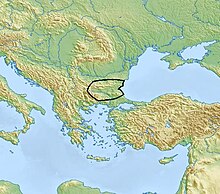Ezero_culture
The Ezero culture, 3300—2700 BC, was a Bronze Age archaeological culture occupying most of present-day Bulgaria. It takes its name from the Tell-settlement of Ezero.
Ezero follows the copper age cultures of the area (Karanovo VI culture, Gumelniţa culture, Kodzadjemen culture, and Varna culture), after a settlement hiatus in Northern Bulgaria. It bears some relationship to the earlier Cernavodă III culture to the north. Some settlements were fortified.
The Ezero culture is interpreted as part of a larger Balkan-Danubian early Bronze Age complex, a horizon reaching from Troy Id-IIc into Central Europe, encompassing the Baden of the Carpathian Basin and the Coţofeni culture of Romania. According to Hermann Parzinger, there are also typological connections to Poliochne IIa-b and Sitagroi IV.
